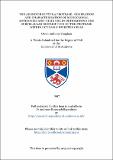The adenovirus type 2 protease : generation and characterisation of monoclonal antibodies and their use in determining the subcellular distribution of the protease within lytically infected cells
Abstract
Production of mature infectious adenovirus type 2 depends on the action of the L3 coded 23kd protease which is known to cleave 7 virus proteins and the host cell proteins cytokeratin K7 and K18. Previous studies have shown the enzyme to be a cysteine proteinase with a novel mechanism of activation requiring the presence of an 11 residue peptide derived from the C-terminus of virus structural protein pVI. It has been proposed that the protease is activated within the assembled virion, although other evidence suggests that the protease is active outwith the virus particle, and is partly responsible for the degradation of the intermediate filament system prior to virion release from the infected cell. The subcellular localisation of the 23kd protease during productive adenovirus infection was investigated using a panel of monoclonal antibodies generated during the course of this study. The monoclonal antibodies were partially characterised and those of interest were epitope mapped using a combination of techniques which included limited and chemical proteolysis, and deletion mutagenesis of the recombinant protein, and screening against overlapping peptides corresponding to specific regions within the 23kd protease. The viral 23kd protease, capsid protein pVIII, and the Ll-52kd probable scaffold protein were shown to colocalise within virus-induced intranuclear clear amorphous inclusions late in infection (24 h.p.i onwards). These inclusions were typically associated with crystalline arrays of assembled virions and are believed to be the same sites which contain relocated PML during the earlier stages of infection. The stmctural appearance of these inclusions varied depending on the fixation method used. The distribution of the viral protease, PML and another cellular protein P80-coilin during the late-phase of nuclear transformation was investigated with possible cleavage of both cellular proteins also partially determined. The viral protease and protein pVIII were also shown to colocalise within cytoplasmic structures but were not found to be associated with cytokeratin K18. The degradation of cytokeratin K18 occurred as early as 20 to 22 h.p.i although the intranuclear distribution of pVI at this stage of infection suggested that the viral protease may be regulated by an as yet unknown mechanism. Isoforms of recombinant wild type 23kd protease (but not Ad2tsl) were detected in vitro which suggested that dimerisation may be an in vivo regulatory mechanism, possibly involving intranuclear trafficking.
Type
Thesis, PhD Doctor of Philosophy
Collections
Items in the St Andrews Research Repository are protected by copyright, with all rights reserved, unless otherwise indicated.

